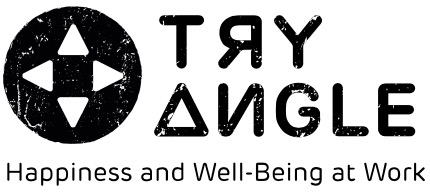The idea that happiness at work is the antidote to stress and burn-out challenges is becoming more and more widespread and accepted. Every day, we meet new companies who are willing to invest in happiness at work. Unfortunately, there are a few happiness killers that lurk in the dark. Bit by bit, they skilfully poison the company culture. This usually happens uncounsciously and always unwillingly. These are four happiness killers that Tryangle’s Chief Happiness, Griet Deca, encounters almost daily throughout companies all over Belgium.
Happiness killer #4: Celebrating happiness at work once a year
It’s hard to imagine what kind of budgets are being invested in excessive initiatives that falsly claim to be supporting happiness at work. A lot of companies narrow down the meaning of happiness at work to a fancy newyear’s reception, the yearly company party or a one-time trip to a cabin in the woods looking for adventure.
This blingbling approach does not take into account that an effective happiness at work strategy has an important basic condition: a company culture that embraces job satisfaction and trust. An organisation that doesn’t treat their employees fairly, equally or respectfully or that doesn’t pay honest wages can impossibly be a good starting point for happiness at work. Only when the foundations of job satisfaction are firm and sustainable, wiggle room emerges for the employee to start thinking about their (or their colleagues) well-being, which is in turn a necessary intermediate step towards happiness at work. Make no mistake, this is a process that needs to be tended to on a daily basis and which requires a lot of babysteps. Having a cool office party can spice up the total package, but never serve as a stand alone.
Happiness killer #3: Negative feedback
“This is terrible!” “You are always late to meetings!” “You handled that all wrong!” Three examples of phrases that are often used in workplace conversations and unfortunately using them means not giving happiness at work even a proper chance. Negative feedback is very much backed into our corporate culture. When things go well, they go well, so we don’t need to talk about them. But watch out when things turn south! We should definitely identify the guilty party and give them a stern talking to. In a best-case scenario, this behaviour comes from the desire to avoid a possible repetition of the same mistake.
What if there were a more comfortable and fun way to reach the same goal? An approach that makes people learn from their mistakes and even be happy to receive feedback on something they can improve upon? Well, there is! And this road happens to have a very sunny destination. It’s a true one-way-ticket to happiness at work when you consciously choose to give constructive feedback. Honestly sharing what could have gone better, but not focus on destruction. Quite the opposite: you put the focus on positive elements and give helpful suggestions on how to do better next time. This is the true secret to transforming mistakes into learning opportunities. Garry Ridge, the CEO of WD40, has experienced first-hand what the positive effects of this can be.
Happiness killer #2: it’s all about the money
Setting your compass to the money wind direction means you’re making it quite difficult for happiness at work to blossom. Usually the idea of happy employees is a fluffy topic that’s on the very bottom of the to do list of a solely money driven company. Moreover, there is so much greed embedded in the culture that often managers like these are convinced that happiness (at work) is something they can buy. But of course they are horribly mistaken.
There is ample research that proves that employees don’t become happier, more productive or more engaged in the long run by getting big bonusses, shiny fitness rooms or bouncy ping pong tables. These may have a short term effect at best, but may also cause a lot of frustration. The overworked and overstressed employee often doesn’t even have the time to use the fancy gym, no matter how much it would benefit his health. And so he continues to crumble under the pressure of accumulated deadlines. Pressure that could have even been solved by hiring more qualified co-workers to come and join the team to help handle the actual workload. But unfortunately there is no hiring budget! This money mindset often takes up all the oxygen in the organisation that makes a positive and happy atmosphere virtually impossible.
Happiness killer #1: the company cactus at the coffee machine
If you want to make sure to avoid all feelings of happiness at work, then you should start cultivating your own company cactus. This particular stingy plant is the kind of colleague you absolutely hope to avoid. Bumping into him when you are on your way to the coffee machine would quite frankly ruin your well-deserved break. Even in an online meeting these types of coworkers sting. It’s the kind of co-worker who – on a good day – will mumble something beneath his breath when you greet him with a kind hello. On a bad day, you’ll just get met with cold silence. The company cactus is also the first to clearly point out that that specific task definitely is not a part of his job discription. He’ll usually make everyone else in the team happy by not participating in the afterwork gettogether. Nobody likes spending time with the company cactus because being around him is quite painful.
We all know one or more company cacti in our own working environment. Quite a pity, because next to a sad little plant, this cactus can have some real added value. Unfortunately, that value isn’t coming to the surface (any more). Did you know that a company cactus never joins the company like that? It can be quite interesting to discover what caused this once motivated employee to transform into this stingy monster. Looking for these reasons can result in a lot of powerful team insights that can help make the company culture stronger when the right actions are taken. The spines usually tell an interesting story about specific issues and bottlenecks that caused conflict, toxic stress or even illness. Tryangle has a lot of experience in these kind of processes, helping the cactus to transform into a more positive and less painful alternative.
Did you know..?
Did you know that it’s often the company cactus that contribute to other co-workers paths towards burn-out? On top of that, the cactus himself also risks becoming very sensitive to the same fenomenon. So you will want to track down this cactus in your team as fast as possible to map and tackle (potential) stress and burn-out issues.
Know more?
Would you like to know how to avoid these pitfalls that kill happiness at work? Would you like to discover how you can build a corporate well-being and a happiness at work strategy and increase the resilience, productivity en engagement of your employees? Then Tryangle is here to help you! We can consult and support on all potential components of happiness at work and help prioritise the ones that would yield the best results for your organisation.
Feel free to get in touch with us to have a chat about our services and how we can be of help to you.





